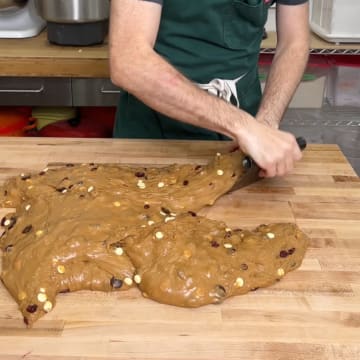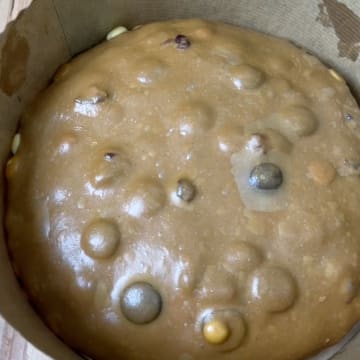Chocottone (Chocolate and Sour Cherry Sourdough Panettone)

Matthew Duffy
November 14, 2022
I can't believe it's already time to start thinking about holiday baking and there's nothing better than my favourite holiday bake, the KING of bread, panettone.
Juniper wanted to start early and teach her sister so that she is ready for the holiday baking season, plus they love the process. We love cooking panettone in the Anova Precision Oven because it does it all. Being able to bake panettone at the exact perfect temperature is a game-changer and time-saver.
Note: The prep time for this recipe does not include the steps for making the pasta madre. Those steps will take 5 days. The prep time includes all of the resting and rising time for the dough, in addition to the mixing steps.
Serves
10
Prep Time
28:23
Cook Time
01:00
3.67 (3)
138
Ingredients
For the Pasta Madre (Stiff Starter)
1 kg
bread or strong flour, plus more if needed
50 g
very active sourdough starter at 100% hydration
Filtered water
For the First Dough
211.1 g
bread or strong flour
115.1 g
filtered water
61.7 g
granulated sugar
63.6 g
Pasta Madre (above)
42.7 g
large egg yolks, cold
91 g
unsalted butter, preferably European-style high-butterfat, at room temperature
For the Second Dough
First Dough (above)
80.9 g
bread or strong flour, chilled for at least 1 hour
64.8 g
granulated sugar
1
vanilla bean (optional)
20.9 g
honey
51.1 g
large egg yolks, cold
7.4 g
cocoa powder
5.1 g
salt
137 g
unsalted butter, preferably European-style high-butterfat, at room temperature
86.1 g
dark chocolate couverture pieces or chips
86.1 g
white chocolate couverture pieces or chips
86.1 g
sour cherries
For the Glaze and Toppings
64 g
granulated sugar
35 g
large egg whites
16 g
fine almond flour
16 g
hazelnut flour
3 g
pastry or soft flour
3 g
cocoa powder
3 g
cornstarch
Pearl sugar, for garnish
Steps
1. Start the Pasta Madre
The first thing you will need to do is convert the liquid sourdough starter to a stiff starter, called a pasta madre. This process will strengthen the starter and allow the long period of fermentation needed for the production of panettone. This step will take 5 days of twice-daily feedings.
On day one, combine 100g flour with the sourdough starter and 40g water in the bowl of a stand mixer fitted with the paddle attachment. Mix on the stir setting until the mixture forms a very stiff, pliable dough, 8 to 10 minutes. Transfer the dough to a clean counter and press into a rectangle. With the short side facing you, fold the top down to the center and the bottom up to meet it, as you’d fold a letter. Rotate the dough 90 degrees and repeat. Repeat once more, then shape the dough into a cylinder, then into a round. Place in a medium bowl and score a deep X on the top with a paring knife. Cover and proof in a proofing box or the Anova Oven set to proof at 28°C (82.4°F) for 6 hours. You can also do this step in a traditional oven, turned off, with the oven light turned on.
For the second feed that day, combine 100g of the proofed starter with 100g flour and 40g water. Repeating the mixing and shaping steps. This time, proof the starter at 18 to 20°C (64.4-68°F) for 12 to 15 hours. For many homes this will be at room temperature.
2. Continue Feeding the Pasta Madre
On day 2, repeat the same process as day 1, except in the first feeding, use 100g flour, 50g starter, and 45g water. Use these same amounts in the second feeding.
On day 3, repeat the same process and amounts as day 2, except that you will only proof the starter for 4 hours after the first feeding.
On days 4 and 5, repeat the same process as day 3. After this, your starter should be ready to use for panettone. If you’re ready to bake in the next few days, continue to repeat the feeding process. If you’d like to store the starter for a longer period of time, cover and refrigerate it for up to 2 weeks. You will need to refresh the starter for 1 to 2 days after refrigerating before baking.

3. Mix the First Dough
In the bowl of the stand mixer, combine the flour, water, and sugar. Mix using the paddle on the stir setting until stretchy and barely sticky, about 10 minutes. Add the pasta madre and half of the egg yolks and continue to mix on the stir setting until incorporated, 5 to 10 minutes. If needed, scrape down the sides of the bowl and the paddle. Add the butter and remaining yolks and continue to mix on the stir setting until incorporated, 5 to 7 minutes. Switch to the dough hook and continue to mix on the stir setting until the dough is smooth and somewhat stretchy, about 10 more minutes. Remove the bowl from the mixer but leave the dough in the bowl for 10 minutes to rest.

4. Proof the First Dough
Transfer the dough to a lightly buttered counter and form into a round. Transfer to a proofing container and mark the sides with two rubber bands; the first where the top of the dough currently is, and the second at 3 ½ times the volume. Cover and proof at 28°C (79°F) until triple to quadruple in volume, 12 hours. The dough should not be shiny but it should have some bubbles.
5. Start the Second Dough
Transfer all of the first dough to the mixer bowl with the flour. Mix on the stir setting until the flour is incorporated, 2 to 3 minutes. Increase the speed to the second setting and continue to mix for 7 to 8 minutes. If you pull on the dough, it should pull back on you and shouldn’t be shiny or loose. Don’t let it stretch out all the way to make a windowpane at this point.
6. Add Sugar and Aromatics
If using the vanilla bean, cut it in half and scrape the seeds into the honey.
Open the mixer and add in half of the sugar, along with the honey, vanilla bean, and about one third of the yolks. Mix on the stir setting until the sugar has fully dissolved, about 6 minutes. Add the remaining sugar and mix on the stir setting for 2 ½ minutes. Increase to the second setting and continue to mix until the sugar has dissolved and the dough has formed a smooth paste, 4 to 5 minutes. Double check that you cannot feel the sugar granules in the dough; if you can, continue to mix, checking every 30 seconds, until they have dissolved.
7. Add Remaining Ingredients
Add the cocoa powder, salt, and another third of the egg yolks. Mix on the stir setting for 1 ½ minutes, then increase to the second speed and mix just until the yolks and salt are well incorporated, 1 ½ to 2 minutes. Be careful not to overmix as this can start to break down the dough.
Stop the mixer and add the butter and the remaining egg yolks. Mix on the stir setting for 2 ½ minutes, then increase to the second speed and mix until the egg and butter have fully incorporated, 7 to 8 minutes. Scrape down the sides of the bowl as needed during this process.
Stop the mixer and add the chocolates and cherries. Mix on the stir setting for 1 ½ minutes, then increase to the second setting and mix until everything is just combined, about 30 seconds. Do not overmix. Remove the bowl from the mixer but leave the dough in the bowl for 20 minutes to rest.

8. Preshape the Dough
Gently remove the dough from the mixer bowl and transfer to a lightly buttered counter. Use a dough scraper to form the dough into a ball. Don’t worry about getting it too tight at this point. Let rest for 20 minutes.

9. Final Shape and Proof
Push two 30cm (12-inch) skewers through the bottom of a 21 by 7cm (8¼- by 2¾-inch) paper panettone mold. Stick one skewer through the top third of the mold and the other through the bottom third. There should be at least 5cm (2 inches) of skewer sticking out on either side.
Shape the dough into a tight ball, using a dough scraper to pull the dough on the table to develop tension. Place into the prepared panettone mold. Proof, uncovered, in a proofing box or the Anova Oven set to the proof quickstart at 29°C (85°F) until the dough has risen to about 3cm (1 inch) from the top of the mold, about 6 hours.

10. Preheat the Oven for Baking
Rack
Place a baking steel or stone on the oven rack.
Sous Vide Mode: Off
Steam: Off
Temp: 310°F
Heat: Top, Bottom
11. Make the Glaze
Whisk together the sugar, egg whites, almond flour, hazelnut flour, soft flour, cocoa powder, and cornstarch until smooth.
12. Glaze and Top
Pipe the glaze over the loaf. Sprinkle the top with the pearl sugar.

13. Bake
Rack
Transfer to the oven and bake until the dough is domed, the top is crisp, and the internal temperature of the top quarter of the dough registers 94°C (201°F), about 1 hour. The top of the loaf takes the longest to cook, so it is critical that you take the temperature of this section of the loaf. It can help to take the temperature of the loaf in more than one spot.

Sous Vide Mode: Off
Steam: Off
Temp: 310°F
Heat: Top, Bottom
01:00 Timer
14. Cool
Immediately after removing the panettone from the oven, invert it upside down and hang it across two stacks of cookbooks so that the top is not touching the counter. Let cool in this position overnight.

15. Serve
Serve or store in a plastic bag for up to 2 weeks. If you want to add a special extra touch, mist the inside of the bag with whiskey or vodka before adding the bread. Leftover panettone also freezes well.

© 2013 - 2025 Anova Applied Electronics, Inc.